#Susanoo shrine
Explore tagged Tumblr posts
Video
flickr
20240503 Anjo shrines 11 by Bong Grit Via Flickr: 龍の装飾。 @Susanoo shrine, Anjo city, Aichi pref. (愛知県安城市 素戔鳴神社)
#Dragon wood carving#Dragon#Rope#Shimenawa#Paper#Shide#Susanoo shrine#Shinto shrine#Shinto#Shrine#Ogawa town#Anjo#Aichi#Japan#RICOH#RICOH GR3#flickr
2 notes
·
View notes
Text
⛩️ Shrines of Little Yoshiwara ⛩️
Hello!
In this post, I'll go through the shrines that can be found at Little Yoshiwara Sim (https://maps.secondlife.com/secondlife/Milarepa/78/117/44)
The largest shrine (that is actually a complex of shrines) is Amaterasu Omikami Grand Shrine. Here you will find shrines to Amaterasu Omikami, Ame-No-Uzume, and Susanoo-No-Mikoto.
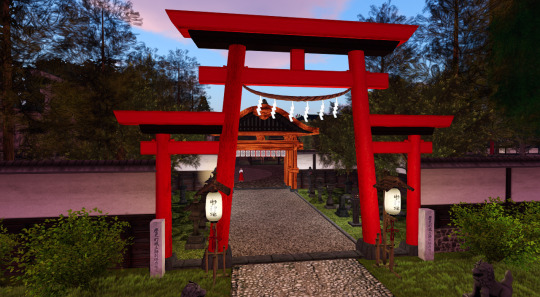
Amaterasu Omikami Shrine Grand Entrance.
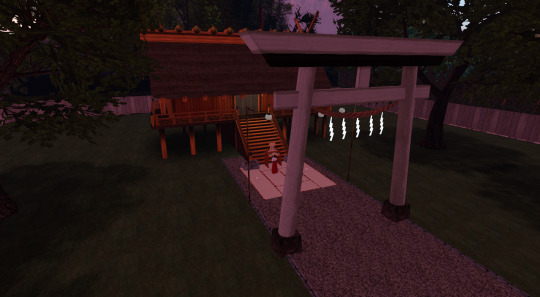


In order: Shrines of Amaterasu Omikami, Ame-No Uzume, and Susanoo-No-Mikoto.
The second largest Shrine is that dedicated to Inari Okami. This shrine is especially popular for festivals and to draw Omikuji.
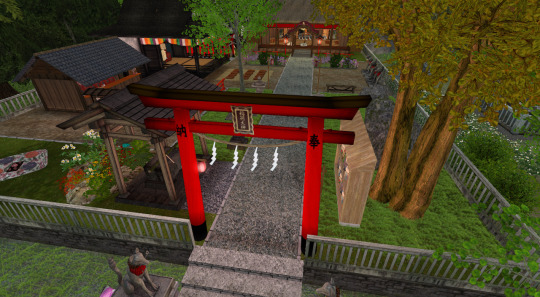
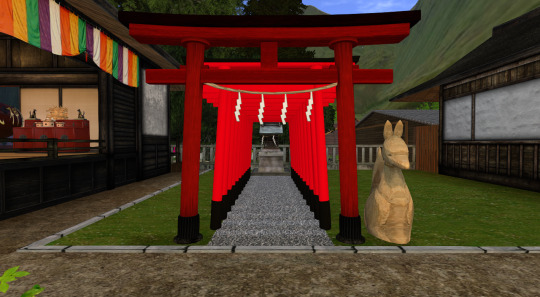
Besides the stone kitsune found all over the shrine, you may sometimes find a few live foxes sneaking around if you're lucky!
The third largest is Hachiman Shrine, popular amongst the Samurai population on the sim. Doves are known to flock to its prime location, near the top of a serene waterfall.

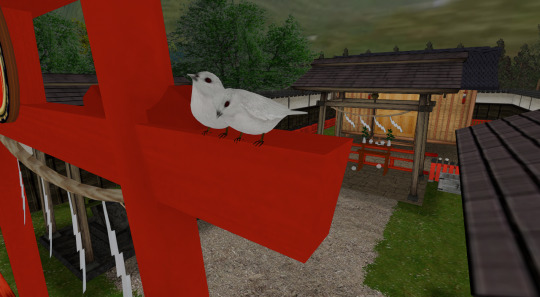
Next is Izanagi Shrine. Even though it is fairly small, this shrine is very important as it is where many purification ceremonies are done.

Next is a small shrine to Takemikazuchi, Kami of Thunder and a Sword Kami, who fought one of the very first Sumo fights. I have never heard of a Sumo match at L.Yoshiwara, but I would love to see that! It is opposite of the Theater, I wonder if there is any reason in particular for that.... If you know, please do share!
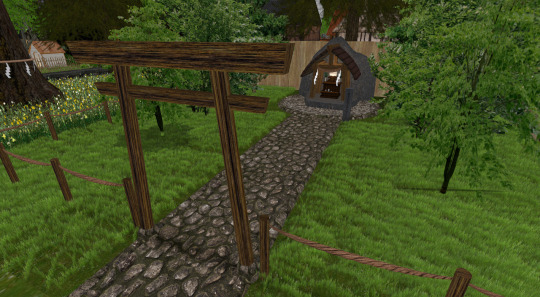
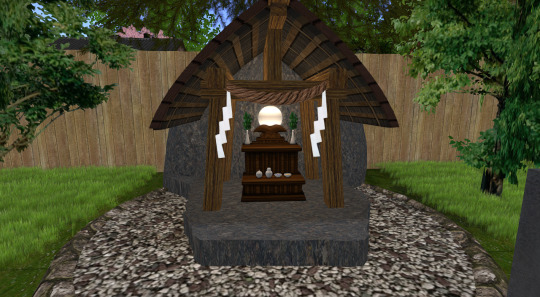
Finally is the Tsukuyomi Shrine. It is more of a Hokora (Roadside shrine), but it is in a beautiful residential area, with a bench nearby and an Apiary behind it. I often find myself coming here on busy nights for peace and quiet.
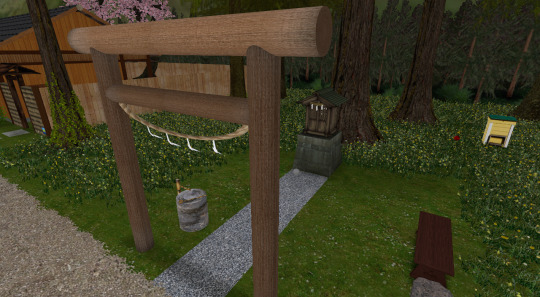
These are all the shrines (so far!) at Little Yoshiwara Sim. I hope you come and visit sometime soon!
Find it here, at: https://maps.secondlife.com/secondlife/Milarepa/78/117/44
6 notes
·
View notes
Text
Kuzunoha
I been doing research about Kuzunoha and Inari/Ukanomitama/Mikestu but I cannot find anything in Japanese Mythology they said how they met and how Kuzunoha became Inari's messanger and how she obtain her on Shrine.
Shinoda Shrine was said to be found in 708 CE, which is 213 years before Abe no Seimei was born. I am searching for movies, books, TV shows and video games that can possibly elaborate on their story, but I had no luck so far.
I found some more information on Shinodamori Kuzunoha Inari Shrine the Japanese Wikipedia and used Google Translate to translate the page.
Her full name seems to be Wakamiya Kuzunoha Hime (若宮葛ノ葉姫). From doing research a yokai can be a deity, but not all yokai are deities. The other main deities enshrined there are Inari/Ukanomitama/Miketsu, Okuninushi, Omiyanome/Amenouzume, Susanoo, and Sarutahiko and according to the translation there is a Koyasu Stone at the shrine that is used to worship Abe no Seimei from afar and to pray for fertility and safe delivery. Note that Seimei was said to ascend to godhood and his house in Kyoto was made into a Shrine in 1007 CE.
There is also another Seimei Shrine in Nagoya.
Anyway, I still looking for official work and fanwork that elorabates on Kuzunoha and Inari/Ukanomitama/Miketsu relationship as well as the relationship between Kuzunoha and the other enshrined deities I mentioned.
#Japanese Mythology#Kuzunoha#Inari#Ukanomitama#Miketsu#Okuninushi#Omiyanome#Amenouzume#Susanoo#Sarutahiko#Abe no Seimei#Shinodamori Kuzunoha Inari Shrine#Shinoda Shrine#Kuzunoha Inari Shrine#Seimei Shrine#Nagoya Seimei Shrine
5 notes
·
View notes
Text
Sean bienvenidos japonítasarqueológicos a una nueva entrega, en esta ocasión vengo a aclarar dudas sobre la diosa Amaterasu dicho esto comencemos. - Amaterasu aparece en los libros kojiki y Nihonshoki que son los más antiguos de Japón, dicha diosa simboliza el sol, la luz, la compasión y la verdad. Además Representa la casa real con la flor de crisantemo, también ha recibido otros nombres como: "Hirume" y "Mukatsuhime. Sus padres eran izanagi(dios creador de Japón) e izanami(diosa del infierno), izanagi al quedar contaminado de la tierra de Yomi fue a purificarse y al quitarse la ropa fueron naciendo los demás dioses y ella nació de su ojo izquierdo. Amaterasu gobernaba el Takamanohara y su hermano Susanoo era el dios del mar. - Amaterasu, estaba asustada por su hermano menor y decidió esconderse en una cueva profunda en Takamagahara llamada "Ama no Iwato" y bloqueó la entrada. Este es el famoso “Amaniwato no Kamigakure”, que el pueblo japonés sigue recreado como una de sus muchas tradiciones populares. - Como ya hablamos en otras publicaciones el sintohismo, es una religión autóctona de Japón que durante la era Meiji sería utilizada para clasificar lo japonés y de lo que no era japonés, los japoneses nunca dejaron el sintohismo de lado. La simbología de la bandera japonesa se remonta desde tiempos muy remotos. - La diosa Amaterasu tiene unos 5000 templos dedicados a ella y se llaman Shinmei Jinja. El templo se localiza dentro del santuario Ise Jingu, también conocido como (oise-san) y el templo se llama Kotai jingu. En la ciudad de Iwato en la prefectura Miyazaki se encuentra el santuario Amanoiwato donde se dice que Amaterasu fue establecida como deidad principal. Amaterasu lo podemos traducir como: Diosa del sol o como diosa solar. - 新作へようこそ、今回は天照大神の疑問を解き明かすということで、始めましょう。 - 日本最古の古事記や日本書紀に登場する天照大神は、太陽、光、慈悲、真実を象徴しています。また、菊の花で王家を表し、「ヒルメ」や「ムカツヒメ」などの別名も持っています。彼の両親はイザナギ(日本の創造神)とイザナミ(地獄の女神)でした。ヨミから大地を離れ、身を清めに行き、服を脱ぐと他の神々が生まれ、左目から生まれました。 アマテラスは高天原を治め、弟のスサノオは海の神でした。 - 弟を恐れたアマテラスは、高天原の深い洞窟「天の岩戸」に身を隠し、入口をふさいだ。これが有名な「天岩戸の神隠れ」で、日本人は多くの人気のある伝統の1つとして再現し続けています. - 他の出版物ですでに説明したように、神道は日本固有の宗教であり、明治時代に日本人とそうでないものを分類するために使用されましたが、日本人は決して神道を放棄しませんでした.日本の国旗のシンボルは、非常に遠い時代にまでさかのぼります。 - 天照大神を祀るお寺は約5,000あり、神明神社と呼ばれています。このお寺は伊勢神宮内にあり、通称「お伊勢さん」とも呼ばれ、皇体神宮と呼ばれています。宮崎県岩戸市には天照大神を主祭神とする天岩戸神社がある。アマテラスは、太陽の女神または太陽の女神として翻訳できます。 - Welcome to a new installment, this time I come to clarify doubts about the goddess Amaterasu, having said that, let's begin. - Amaterasu appears in the Kojiki and Nihonshoki books, which are the oldest in Japan, this goddess symbolizes the sun, light, compassion and truth. It also represents the royal house with the chrysanthemum flower, it has also received other names such as: "Hirume" and "Mukatsuhime. His parents were izanagi (creator god of Japan) and izanami (goddess of hell), izanagi when contaminated by the earth from Yomi she went to purify herself and when she took off her clothes the other gods were born and she was born from her left eye. Amaterasu ruled the Takamanohara and her brother Susanoo was the god of the sea. - Amaterasu, scared of her younger brother, hid in a deep cave in Takamagahara called "Ama no Iwato" and blocked the entrance. This is the famous "Amaniwato no Kamigakure", which the Japanese people continue to recreate as one of their many popular traditions. - As we have already discussed in other publications, Shintoism is an indigenous religion of Japan that during the Meiji era would be used to classify what is Japanese and what was not Japanese, the Japanese never abandoned Shintoism aside. The symbology of the Japanese flag dates back to very remote times. - The goddess Amaterasu has about 5,000 temples dedicated to her and they are called Shinmei Jinja. The temple is located inside the Ise Jingu shrine, also known as (oise-san) and the temple is called Kotai jingu. In the city of Iwato in Miyazaki Prefecture is the Amanoiwato Shrine where Amaterasu is said to have been established as the chief deity. Amaterasu we can translate it as: Goddess of the sun or as solar goddess.
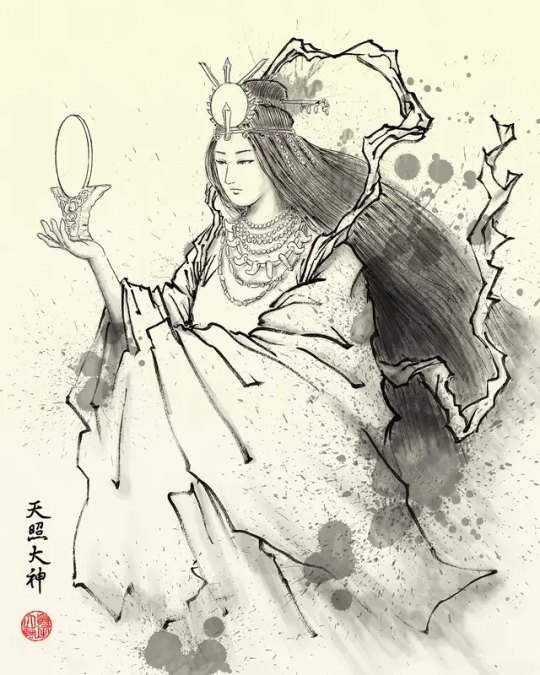
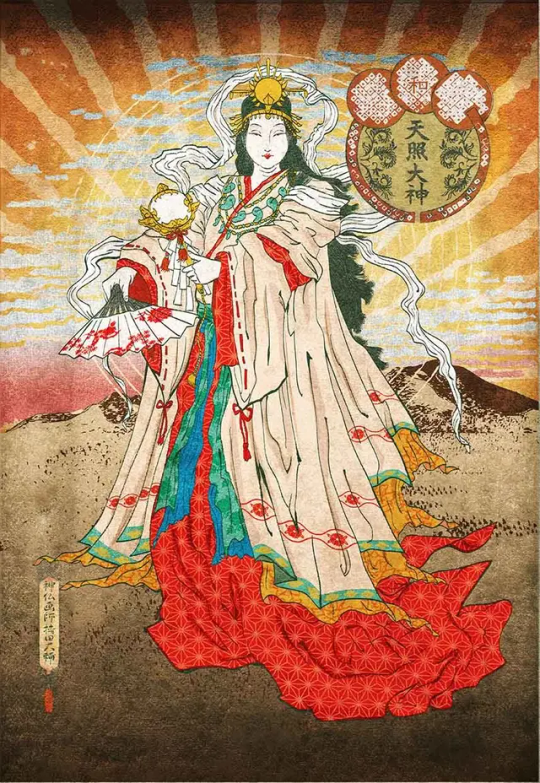
#日本#アマテラス#アート#写真#ユネスコ#文化#神話#神道#シントイズム#japan#amaterasu#art#photo#unesco#culture#mythology#synthology#sintoism
61 notes
·
View notes
Text
Spinning around in a chair consumed with thoughts about the magical girl Izuna AU, specifically about what cool patron gods the others could use as sponsors if they got hit with the magical girl beam. + What would happen after the 'season 1' phase of the story
So, Susanoo, little brother of Amaterasu, hears that Kaguya has gotten free.
He decides that yk what? Time to fuck with the big sister. Kaguya got sealed away for reasons anyways, so why shouldn't he at least make jokes about putting her back where she came from?
Meanwhile Amaterasu is busy yelling at Kaguya for hours then making out with her for even longer as Izuna stares in horror. (Tobirama does not give a shit, he got both of his brothers back at this point and could not be happier. As far as he considers, he's retired. His contract with Kaguya is half broken right now anyways)
So now lets fully shift gears away from Tobirama and Izuna's seeming end of the adventure, and turn to Madara's POV
So Susanoo finds Madara, whos a) compatible with his power via being one of Amaterasu's children. And b) The reincarnation of one of the original guys who sealed Kaguya away.
Perfect match!!
idk how he convinces him to help exactly, maybe Susanoo spins a bit of a story, maybe he pokes at and reawakens the parts of his soul with a grudge against Kaguya, maybe he, like Kaguya, offers him a wish-- Im undecided.
Long story short though, magical girl Madara with Susanoo as his sponsor
Somehow Hashirama finds out, and not one to leave his best friend to his task alone, now gets to join him in the adventure as the powerless backup!! Im such a sucker for that trope.
Susanoo does spend an especially long time squinting at Hashirama before saying something about he has surprisingly strong ties to the earth. Strong enough that he might be able to actually handle a contract with some sort of nature kami -- but only if he can find one willing to offer him their power.
Shrine maiden Mito makes a come back to help back them both up with some cool priest magic. Her ancestor helped to seal Kaguya away with Hashirama and Madara's past incarnation, and theres little clues that can help piece together their past lives and powers littered around her family shrine.
The story dives a bit into Madara and Hashirama learning about their past life. Before, they were able to avoid the karma (good and bad) theyd earned in that life via being ignorant to it. But now that they not only know about their past lives but have now interacted with the gods again (thanks Susanoo, really) they're getting regularly harassed by spirits and minor gods for an array of reasons. Past crimes, bets they lost and deals they forgot or werent able to fuffil,
Thanks Susanoo, really. Really.
So anyways, Susanoo kind of forgot the original reason he contracted Madara (he just got distracted having too much fun watch him be harassed by spirits)
But one day Tobirama shows up in costume while Madara is struggling, figuring hed help.
(Its important to note that just like before, unless you see the magical girl transformation in real time with your own two eyes, they're all prevented from recognizing/remembering each others faces when in costume. )
Susanoo is like "OH FUCK RIGHT!!" and starts yelling at Madara to like fuffill his destiny and punch out this guys lights
Madara is like ???? he helped me tho ???? but Susanoo points at the big glowing "I only gave you this contract so you could fight Kaguya and if you pull out now Ill leave you alone without the powers to fight off all these spirits who keep trying to eat you" sign
And Madara is like fuck and just goes for it
Tobirama does not appreciate his help being returned like this.
Quick interlude about Tobirama's situation:
So, last time we saw him, Tobirama was risking a full transformation into a moon monster. So why is he seemingly ok using Kaguya's powers now?
The answer is that its because hes stopped giving out contracts on Kaguya's behalf. He can handle Kaguya's power, just in small amounts. Though it still does sometimes cause some discomfort. At his lowest point he was basically acting like a battery for all the power Kaguya couldnt hold bc of how she was sealed. There was way too much power there for any mortal to hold, its honestly a miracle he survied. But now Kaguya is fully free and Tobirama barley even uses her power. (Why would he? He got what he wanted from it, his brothers)
He still has the contract with her because keeping it in place is what keeps his brothers alive. He cant break that without killing his brothers too, but he doesnt mind. Kaguya isnt that bad-- Even tho having Kaguya around means Amaterasu (and thus Izuna) is around too.
Anyways, Tobirama at his strongest is stronger than Izuna (he did kind of win that final battle in releasing Kaguya), but also risks going insane and or exploding from the weight of Kaguya's power. Even if he recovers after, the more times he uses that kind of power, even once, the more he risks long term damage. He now purposefully only uses power in small amounts to avoid that risk. Take that as you will
Alright back to the story;
So. Tobirama and Madara are fighting now. Madara does not want to fight but Susanoo is pretty much blackmailing him at this point and also cheering on loudly from the inside of Madara's head.
Tobirama meanwhile is very down to kick the ass of the apparent jackass who decided to take a swing at him after he went well out of his way to help him out. Also at this point hes a lot more experienced than Madara when it comes to fighting other magical girls, so.
Yeah. Madara gets his ass beat. Not too bad, but like, enough.
He kind of thinks he deserved it too, hes really embarrassed about it. He has MANNERS. Hed never DO this to someone who just fucking SAVED him. And they're the first other actual fr magical girl hes ever met !!!
Madara has his head in his hands in fucking agony rn, Susanoo why would you DO THIS TO HIM???
Tobirama stomps off to go tell Izuna about a seemingly weirdly prone to violence magical girl in town (Izuna, when told that Madara punched Tobirama in the face out of nowhere, quietly mumbles *damn I wish that were me.* Then gets his ponytail yanked on angrily)
(Amaterasu and Kaguya are actually mildly concerned, if only bc another magical girl = another kami physically present in town)
Madara slinks home to tell Hashirama the bad news about possibly having just made an enemy out of whatever community of magical girls apparently exists in town (and its to note that neither of them actually realized they were AROUND)
And then Susanoo drops the "oh yeah that guy was contracted by Kaguya btw so like youre going to either have to kill him or go through him and seal his deity if u wanna fulfill our deal ;)"
Madara: *agonized noises*
Well! At least the moon rabbit contractor isnt someone Madara and Hashirama actually know! Haha thatd suck. That would really, really suck.
So, with Madara's karma pulling in all sorts of spirits, minor gods and monsters to town, we return back to that 'villain/monster of the week' schedule
Meanwhile Izuna and Tobirama are getting pissed at whatever the fuck is attracting all these spookies into town. They thought they were going to get to be retired!!! What the fuck is this!!!!!! Somehow they're able to figure out all these monsters are being attracted by the pull of the new magical girl in town, who keep trying to start shit with Tobirama for seemingly no reason.
In one of those fun 'oh no my friend is in trouble and its all on me to save him!!!' moments, Hashirama manages to find and convince some earth kami to contract with him and join Madara in his fight. He cant just let Madara fight alone! And it may mean inviting the bad karma of his past life to haunt him, but so what? Hed do anything to help out his friend!
(and now there are TWO magnets for spirits gods and monsters to attract them into town, oops)
SO THEN !! With another fun funky turn in the story we enter an arc thats basically the most painful series of miscommunications and secret identities ever. Where Madara, Hashirama and Mito team up to fight against Tobirama and Izuna.
Only none of them realize who the fuck the other is.
Oh ?? Whats that ???? You thought I forgot about Touka and Hikaku?????? WRONG
While Madara and Hashirama fight with Izuna and Tobirama, shrine maiden Mito finds herself faced with two seemingly normal people, just like her. Only not exactly.
Hikaku is still armed with that kendo sword blessed by Amaterasu from the last final battle between Izuna and Tobirama, and now hes had plenty of time to learn how to use it. Sun sword time !!!
Meanwhile Touka has been practicing balancing more of Kaguya's power via a contract through Tobirama. With time, effort, and Tobirama's help, shes able to do some like cool partial transformation into a moon-monster or smthn. Maybe she gets a cool glowy arm?? I really dont know but something like that
I'm actually really into how they continue to contrast eachother. Like, Hikaku's sword contains the purifying light of Amaterasu's sun, which is what's used to chase out Kaguya's power. And Touka is filled with that same barley managed corruptive power of Kaguya's. It's neat! It'd also make sense from a tactical standpoint to pair them up together to fight. If the power gets to be too much for Touka and she starts to loose herself, Hikaku can give her a whack and hopefully help bring her back to reality.
Anyways, while the magical girls cant recognize eachother or be recognized, and Mito might have some fun seal to use to hide her own identity in a similar way, Hikaku and Touka dont!
Maybe they go into the fight without disguising themselves as like an accidental oversight on their part (too used to the protections Tobirama and Izuna have to consider themselves) or maybe they use basic masks, I dunno
Either way, trying to disguise themselves or no, I dont think Madara and Hashirama will fail to recognize their cousins.
Queue another "oh god I know their secret identity but they dont know mine and its !! someone !!! I know !!!!!!!" (can you tell I like this kind of agony because I do)
Well. At least the magical girls arent people they know !!! hahahahahahha. Yeah.
Back to Tobirama and Izuna's POV;
So, you might have realized it by now. But Tobirama's contract with Kaguya is what keeps his brothers alive. In other words, if Kaguya is sealed again, they will instantly die!
Yeah !!! So theres that !!!!
Even if Tobirama and Izuna werent friends, which they kind of are now (and maybe they should also kiss that would be neat) Even if Amaterasu wasnt really pissed and constantly yelling about the gall of some upstart nobodies coming into HER town and putting HER girlfriend back into the moon. Even if Izuna hadn't been interacting a bit more with the revived senju brothers--
Well, Izuna would still be helping Tobirama here. Hes not going to just let Itama and Kwarama die.
So yeah, safe to say that these guys are motivated and out for blood.
Good news Susanoo, you no longer have to worry about goading Madara into attacking first!! Izuna and Tobirama are out for his fucking head!!!
Anyways; No matter how it ends I dont think Susanoo especially actually cares about sealing Kaguya away fr. He really just came to fuck with Amaterasu, and then stayed to watch Madara flail as hes harassed by his past lifes karma.
because I dont want to see Kawarama and Itama fucking dead, Im gonna say Izuna and Tobirama will probably win this one around. Susanoo grumbles about loosing but then Amaterasu spots him and starts screaming directly into his ear
There is however a very fun ending out there where Madara and Hashirama win; In the process managing to make Tobirama go fully insane in his attempt to fight them with too much of Kaguya's power; killing both Itama and Kawarama; Putting Izuna in a coma; Leaving Touka now struggling with the moons power stuck in her without Tobirama to help regulate it; And leaving Hikaku with an arm now unable to ever hold his sword properly again.
Fun times!!
Season 3 after the bad ending is actually Touka and Hikaku picking up the pieces and trying to find a way to fix it all as Madara and Hashirama struggle to comprehend what they've unknowingly done to their own families.
Idk, I'll think about it later
#magical girl izuna#birds fic talk#magical girl au#izuna uchiha#madara uchiha#tobirama senju#hikaku uchiha#touka senju#senju hashirama#hashirama senju#tobiizu#uchiha madara#senju touka#touka#hikaku#madara#tobirama#izuna#amaterasu#kaguya otsutsuki#mito uzumaki#mito#uzumaki mito#uchiha hikaku#magical girl
56 notes
·
View notes
Text
Demon king, demigod, drunkard, dōji: exploring the archetypal oni, from Ōeyama to Lotus Eaters
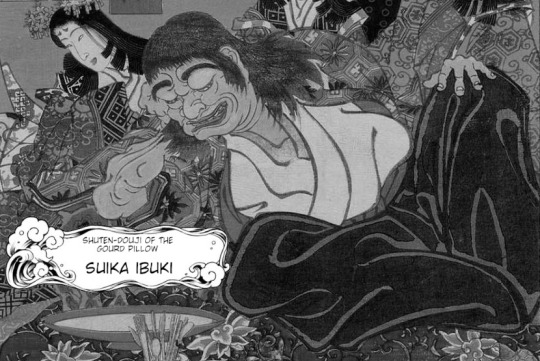
By popular demand, I wrote an article covering the background of Shuten Dōji and his underlings, and how it influenced Suika’s character and the idea of the Four Devas of the Mountain in Touhou. It was initially scheduled for last month, but I’ve experienced unplanned delays. Read on to learn if you want to learn what Suika has to do with Yamata no Orochi and Mara, if it’s true that oni never lie, and more. I will also explain why making your own fourth Deva of the Mountain is entirely fair game and anyone telling you otherwise is wrong about the source material which inspired ZUN. The article contains some spoilers for WaHH and a number of other Touhou installments, so proceed with caution if that might be an issue for you.
Ōeyama, or Shuten Dōji: origins
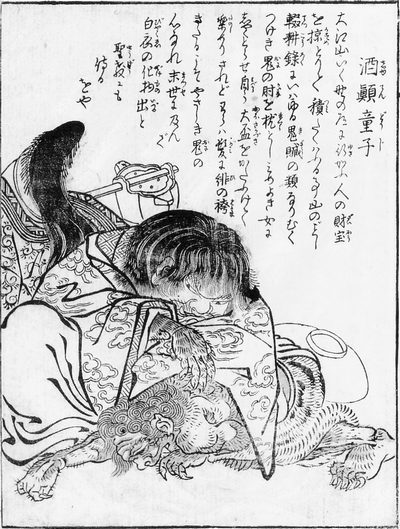
Shuten Dōji, as depicted by Sekien Toriyama in Konjaku Gazu Zoku Hyakki (wikimedia commons)
It perhaps seems a bit silly to start this article with an inquiry into the identity of Shuten Dōji (酒呑童子, “wine-loving youth” or something along these lines). After all, while Touhou characters are often based on obscure figures, Suika is hardly an example of that category. Shuten Dōji is arguably THE archetypal oni, known even to people with limited familiarity with Japanese mythology and folklore. And yet, the matter is nowhere near as clear cut as it might seem at first glance. From a certain point of view, Shuten Dōji might not even exactly be an oni, strictly speaking. A book from Nara simply titled Ōeyama ("Mt. Ōe") offers a detailed account of Shuten Dōji’s origin. His father was not a man or a demon, but rather a mountain god, Ibuki Daimyōjin (伊吹大明神). That’s not all, though - according to a local belief, Ibuki Daimyōjin was actually Yamata no Orochi. How does that even work? Contrary to the more widespread tradition, the inhabitants of the area around Mt. Ibuki from the Muromachi period onward believed that Orochi survived his confrontation with Susanoo and hid in the mountains. That’s actually not even the most unusual variant tradition about Orochi. A widespread belief through the middle ages was that he eventually managed to redeem himself, becoming a divine dragon (shinryū, 神龍) residing in the dragon palace under the sea. In that capacity, he was sometimes associated with emperor Antoku, with the latter even claimed to be his reincarnation, for example in a local legend associated with the Atsuta Shrine, preserved in the noh play Kusanagi. In esoteric Buddhist doctrine Orochi was sometimes perceived as a local manifestation (suijaku) of the buddha Yakushi - much like Susanoo was. Ichijō Kaneyoshi in his Nihon shoki sanso (1455–1457) went into yet another direction, presenting the snake as identical with the naga girl from the Lotus Sutra. Apparently, he specifically means the version of her from Shaku Nihongi… who is identified there as Susanoo’s wife, down to being equated with Kushinadahime (this was not unusual in itself - Susanoo was equated with Gozu Tennō based on similar character, so it was sensible for their wives to be seen as analogous). This effectively created a scenario where Susanoo married his nemesis.
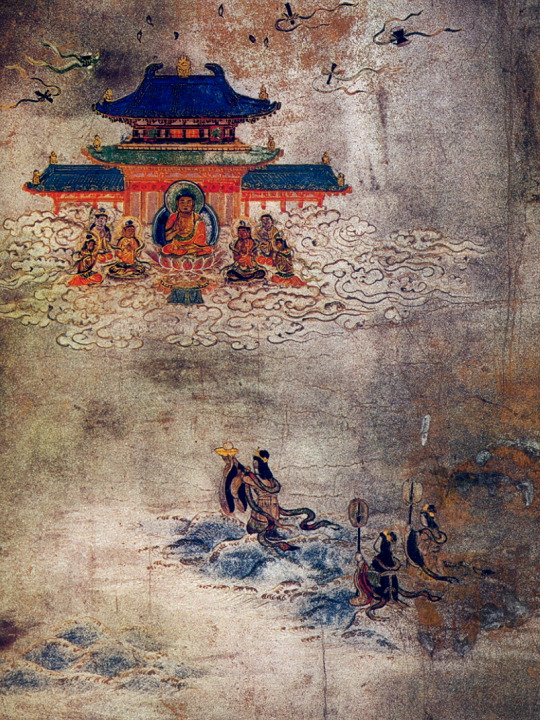
A Japanese depiction of the naga girl offering a jewel to the Buddha, as described in the Lotus Sutra (wikimedia commons)
Anyway, back to Shuten Dōji. According to Ōeyama, Ibuki Daimyōjin, before he even came to be known under this name, fell in love with the daughter of a local feudal lord, Sugawa. He started visiting her at night and she as a result eventually became pregnant. The identity of the visitor was unknown to her father, and out of frustration and fear that nefarious supernatural forces might be involved he eventually contacted various religious officials to perform exorcisms. Needless to say, Ibuki Daimyōjin was less than thrilled, and decided to display his divine wrath through rather conventional means: Sugawa was struck by illness. He once again summoned various Buddhist monks and onmyoji, this time to attempt to heal him. They concluded that the disease will disappear if the deity who caused it is properly honored, and established formal worship of Ibuki Daimyōjin, which apparently did indeed help. Sugawa’s daughter eventually gave birth to Ibuki Daimyōjin’s child. The child started to cause problems at the age of three: his love of alcohol manifested for the first time, earning him the moniker of Shuten Dōji. By the time he was ten, his misdeeds were too much for his family to bear with and his grandfather decided to send him to Mt. Hiei to become a novice (chigo). The monastic lifestyle didn’t really change much though, and Shuten Dōji continued to drink. Eventually he managed to convince three thousand monks (sic) to drink with him and to join him in an “oni dance” during which everyone put on masks representing demons. The festivities lasted seven days. When Shuten Dōji woke up afterwards, he realized his mask had fused with his face, and he was no longer able to take it off. The other participants fled out of fear of his new form.
Shuten Dōji’s Mt. Hiei career was subsequently cut short by Saichō, the founder of the Tendai school of Buddhism. After learning what happened, he prayed to the buddha Yakushi and to Mt. Hiei’s protective deity Sannō Gongen to banish Shuten Dōji. It's worth pointing out that presenting young Shuten Dōji and Saichō as contemporaries is basically standard, and pops up in multiple legends. There are variants where Kūkai, the founder of Shingon, plays a similar role instead, to. They actually lived some 200 years before the other historical figures who appear in Shuten Dōji narratives, but this is not an oversight. It is a given that a partially divine being would live for much longer than a human.
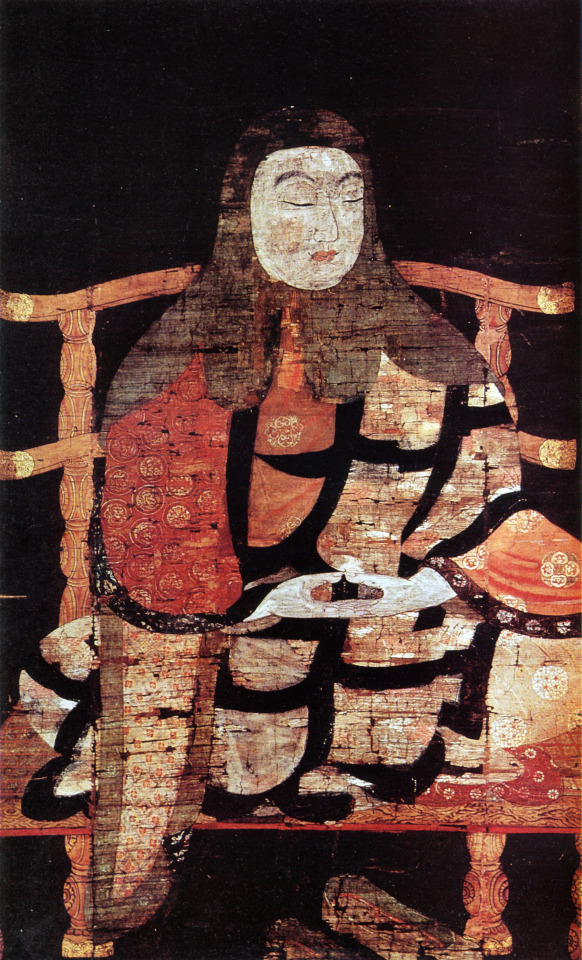
A Heian period portrait of Saichō (wikimedia commons) As a result of Saichō’s success, Shuten Dōji had to flee. He tried to return to his grandfather’s residence, but this was no longer an option for him. He temporarily hid on Mt. Ibuki, but eventually left for Mt. Ōe, where he finally became a veritable "demon king".
The reason why Shuten Dōji was rejected by his family is that he was recognized as an “oni child” (鬼子, onigo). In the folkloric sense, this term refers to supernatural beings which are nonetheless partially human by birth. Not necessarily part oni, though. Another well known onigo, Sakata no Kintoki, was the son of a yamauba, for instance. However, Yanagita Kunio noted that this term also referred to children born with teeth (a real, though very uncommon phenomenon), who were believed to turn into oni - much like how Shuten Dōji did. He states that especially before the Edo period this lead to cases of child abuse or outright murder. In some cases sending the child to become a member of Buddhist clergy was seen as a remedy. For example, a twelfth century monk named Jōjin in a letter relays that he suggested this to the mother of such a newborn. It is not hard to see that Ōeyama likely consciously references this custom.
The other origin of Shuten Dōji
Yet another tradition is preserved in a variant of the standard Shuten Dōji tale which switches the location of his demise from Mt. Ōe to Mt. Ibuki: here Shuten Dōji is not just any demon, but a manifestation of Mara. As in, the opponent of the Buddha and demon king of the sixth heaven, not some other accidentally similarly named figure.
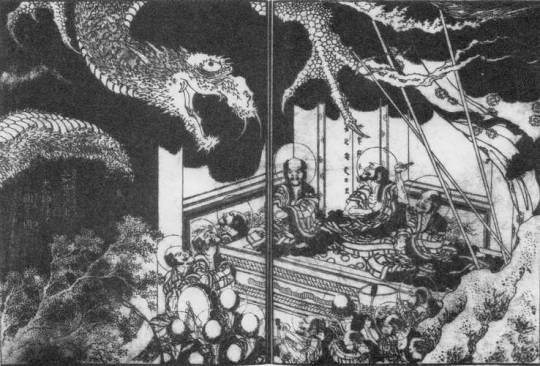
Mara, as depicted by Hokusai in Shaka-goichidai-zue (wikimedia commons)
It is presumed that this portrayal of Shuten Dōji might be tied to medieval Japanese traditions pertaining to Mara. They might sound unusual today: he was both a “demon king” (魔王) obstructing enlightenment, as expected, but also a jinushi (地主), or “landholder deity”. From the Buddhist point of view, jinushi were ambivalent figures: on one hand, their presence was responsible for bestowing specific locations with holiness. On the other hand, they could resist Buddhism as demonic forces, and had to be subjugated or converted to prevent that. Mara was the ultimate jinushi, the king of the world as a whole. A role already attributed to him in earlier Buddhist sources was basically adjusted for this framework. The jinushi version of Mara originated among proponents of the imperial court and mainstream Buddhist institutions, but it curiously also gained traction among the opponents of these structures. Mara became somewhat of an anti-establishment icon more than once, essentially. A legend links him with (in)famous rebel Taira no Masakado (who you may know from SMT) for this reason.
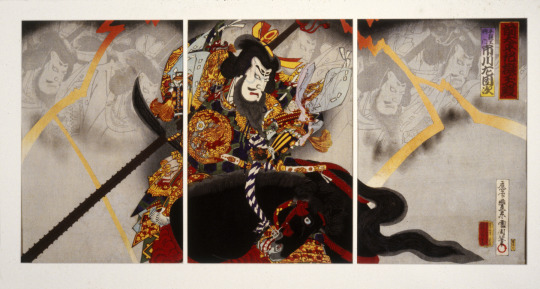
Masakado, as depicted by Kunichika Toyohara in Sen Taiheiki Gigokuden (wikimedia commons)
Other similar examples are also known. A local legendary figure from the Tsugaru peninsula in modern Aomori prefecture, Tsugaru Andō (津軽安藤), who after a failed rebellion fled to Hokkaido, was proudly described as a vassal of Mara by local officials who claimed descent from him. Prince Sutoku, a banished opponent of emperor Go-Shirakawa, swore a vow to become like Mara. Oda Nobunaga famously referring to himself as the “demon king of the sixth heaven” in a letter to Takeda Shingen is likely another example. Reportedly a related belief that praying to the jinushi version of Mara can spare one from conscription persisted as late as the early 20th century, though generally he belongs to the realm of “medieval myths” which faded with the ascent of a new system of values in the Meiji period, in which the early imperial chronicles were favored. Even though it is largely forgotten today outside of specialized scholarship, there is much more to this Mara tradition. It led to the development of one of my favorite Japanese myths with no popcultural reception, but you will have no wait a few more weeks to learn more. It has been argued that behind the identification of Shuten Dōji and Mara might reflect a historical event of the sort which led to associating the latter with figures such as Masakado. In other words, that Shuten Dōji in this case might be less a demon and more a demonized form of some opponent of imperial or religious authorities.
It has been argued that the Ibuki version was the result of combining an original oral narrative, a precursor of the textual versions we are familiar with today, with the memory of the death of a certain Kashiwabara Yasaburō, a bandit leader, in 1201. It has in fact been argued that even the mt. Ōe version might simply be a particularly fabulous reinterpretation of a punitive mission against bandits robbing and murdering travelers. Such rationalist explanations are not exactly new - Ekken Kaibara already argued in the Edo period that the legend of Shuten Dōji must have been the reflection of the downfall of a real bandit who perhaps wore the mask of an oni while committing robberies.
It’s important to bear in mind to not go overboard with this speculation, though. Ultimately the Mt. Ibuki version has a more pronounced religious character than other variants in general: Shuten Dōji’s nemesis Raikō’s is identified as a manifestation Bishamonten or Daiitoku Myōō (in the latter case, Bishamonten and the three other heavenly kings correspond to his four retainers), emperor Ichijō with Miroku (Maitreya), and Abe no Seimei, who plays a minor role in vanquishing the demon, with Kannon. These equations reflect the idea of honji, or “true nature” of Buddhist figures, who were believed to take various guises through history to help people reach nirvana, for example these of local deities or historical figures. The best known example of application of this doctrine in Japanese Buddhism is obviously the historical phenomenon of honji suijaku, which was focused specifically on kami.

A Kasuga mandala representing the correspondences between Buddhist figures and local kami (source; reproduced here for educational purposes only)
The legend of Shuten Dōji
Regardless of which mountain is identified as the residence of oni, and of whether the dramatis personae are identified with Buddhist figures or not, the plot of the various versions of the legend of Shuten Dōji surprisingly does not vary all that much. While it is reasonably well known, I figured it won’t hurt to summarize it here anyway, especially since the information above should make it possible to view it from many new angles.
The oldest surviving version, Ōeyama Ekotoba (“Illustrations and Writing of Mt. Ōe”), presumably based on preexisting oral sources, comes from the fourteenth century, specifically from the Nanbokuchō period. However, the story only reached the peak of its popularity a few centuries later, in the Edo period. This was a part of a broader phenomenon: preexisting tales about warriors matched the sensibilities of the new ruling classes and were kept in circulation by them, but eventually they also became a part of urban popular culture. Many adaptations were produced, including noh plays and ukiyo-e. To put it very colloquially, the heroic warriors and demon quellers from the previous periods became the Edo period counterpart of contemporary superhero media. This is a genuine comparison employed in scholars, for clarity, not a joke. As remarked by Bernard Faure, the most widespread version is basically framed as if it was a tabloid story from the Heian period. In 995, young women (and in some versions men too) disappear whenever a particularly violent storm occurs, and nobody knows how to stop it. Not even the power of Buddhist exorcisms is enough. Seeing as in the portrayed time period that was pretty much the universal solution to supernatural problems, this is a big deal.
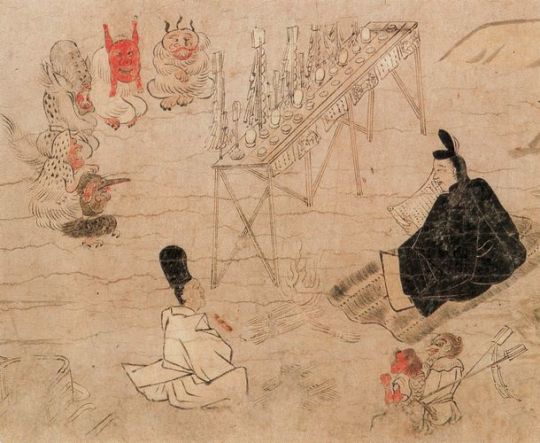
Abe no Seimei (right) in the Fudo Rieki Engi (wikimedia commons) This is a source of distress for a certain official, Ikeda Kunikata (or, in some version, Kunitaka), whose only daughter is among the kidnapped women. He decides to seek the help of the Heian period superstar Abe no Seimei, arguably the most famous onmyoji in history. Alternatively, the expert contacted is a certain Muraoka no Masatoki, who to my best knowledge is a fictional character and doesn’t appear anywhere outside of some variants of this tale. Either way, thanks to this intervention it is possible to identify the culprit as a demonic being residing on Mt. Ōe (or alternatively on Mt. Ibuki). In one of the versions featuring Seimei he specifically identifies him as a tenma (天魔), “heavenly demon” - a term commonly used to refer to tengu (as ZUN does in Touhou) and to servants of Mara (overlapping if not identical categories, really; stay tuned for a future article exploring this). However, onmyoji arts are not enough to stop the crisis; all Seimei can guarantee is that Kunikata’s daughter will survive, but he has no way to confront the demon directly. Kunikata therefore decides to bring the case to the attention of the emperor, Ichijō. He holds a meeting with various ministers, who note that in the past a similar case was solved by Kūkai (recall his already mentioned association with Shuten Dōji). However, there are no monks of equal skill left, so his feat cannot be repeated.
It is then concluded that the only way to end the demon’s reign of terror it is to send the strongest warrior they were aware of, Minamoto no Yorimitsu (Raikō) and his four retainers, Watanabe no Tsuna, Sakata no Kintoki, Taira no Suetake, and Tairi no Sadamitsu, on a mission to kill him. Raikō is also assisted by Fujiwara no Yasumasa (Hōshō) and his anonymous attendant, but these two never gained much prominence as characters in this narrative. Additionally, in some versions other figures from the same period - Taira no Muneyori, Minamoto no Yorinobu (Raikō’s younger brother) and Taira no Korehira - are namedropped as potential candidates considered by the emperor, but they all reportedly decline to partake out of fear.
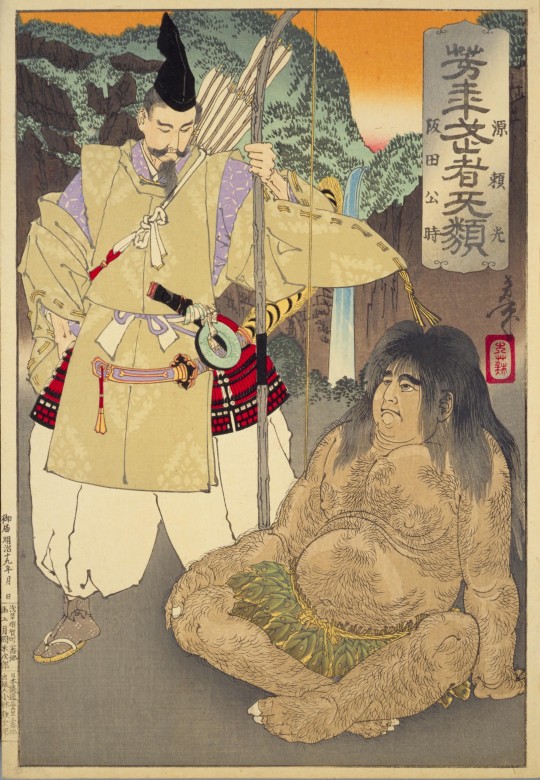
Raikō and Kintoki, as depicted by Yoshitoshi Tsukioka (wikimedia commons)
Preparations started with prayers in Sumiyoshi, Kumano, Kasuga and, in some versions, Hie shrines. They did not go unanswered. Raikō and his retainers subsequently encounter a group of shugenja (mountain ascetics) who turn out to be the manifestations of the deities they paid honor to: Sumiyoshi Myōjin, Kumano Nachi Gongen, Hachiman (here addressed as a bodhisattva) and, if the Hie shrine is included in a given version, Sannō Gongen. They explained that to safely enter the fortress of Shuten Dōji, Raikō and his men must disguise themselves as shugenja (that’s because the legendary first shugenja, En no Gyōja, famously had an entourage of demons). They also provide him with supernatural wine. They state the oni will inevitably drink it due to their fondness of alcohol, only to end up poisoned as a result. In some versions they vanish afterwards, but in others they continue to accompany Raikō. The protagonists then encounter a woman washing blood stained clothes. In some versions she is described as elderly, and states she has lived for 200 years as a servant of Shuten Dōji. In the most widespread Edo period version, she is young and says she was only kidnapped a year earlier, though.

Encounter with the woman washing bloody clothes (NYPL Digital Collections) Regardless of her age, she reveals some additional information about Shuten Dōji, though that also varies depending on the version. In some, she explains that he looks like a human during the day, but takes the form of an oni at night. His human form is specifically that of a dōji, literally “child”, but we’ll get back to the full context of this term later. In any case, I think it's safe to say the shape and size changing is where Suika'a ability came from. In another variant, the woman warns the heroes that Shuten Dōji is enraged by Abe no Seimei’s actions, as the onymoji apparently figured out in the meanwhile how to keep the people of Kyoto safe by employing a number of shikigami (a standard part of his repertoire). There are no further stops on the journey, and shortly after the encounter with the woman of variable age Raikō and his men enter the mountainous land of the oni. Especially in the older versions, it’s a place completely out of this world, with all four seasons occurring at once. Once they enter the fortress located there, they instantly encounter Shuten Dōji… and ask him for a place to stay for the night.
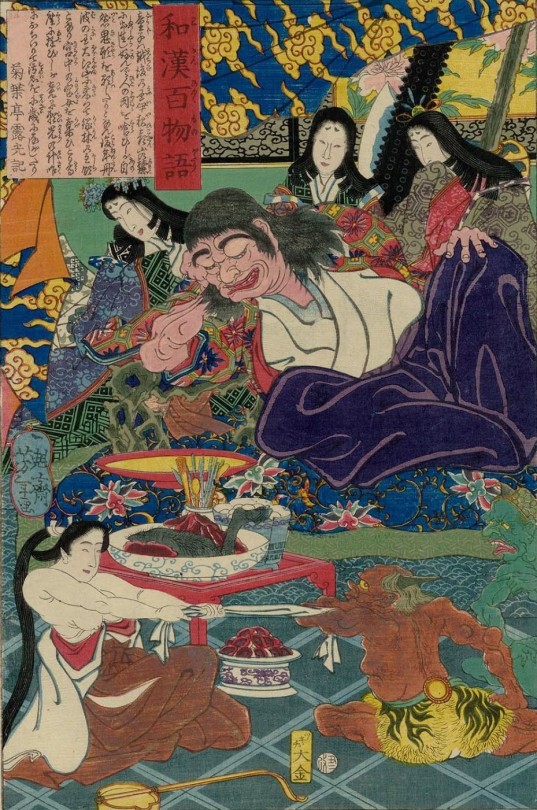
Distinctly human-like Shuten Dōji, as depicted by Yoshitoshi Tsukioka in One Hundred Ghost Stories from China and Japan (LACMA; reproduced here for educational purposes only)
Rather unexpectedly, he instantly agrees. He then tells them about his past; this largely a shorter version of the legend already discussed earlier, though with nothing predating the Mt. Hiei section mentioned. We also get a specific date for his arrival on Mt. Ōe, 849. This doesn’t last long, though, and soon he invites the protagonists to partake in a feast with him. This is obviously not a regular party, and while the individual versions can be more or less graphic, it is clear that the oni are consuing the flesh and blood of their captives. Despite various horrific sights, Raikō maintains composure. He uses the opportunity the feast presents him with to offer Shuten Dōji the sake he received from the three (or four) deities earlier. As expected, Shuten Dōji gets drunk, and leaves to rest in his chamber.
The other oni continue to party. In some versions, some of them try to approach the protagonists by disguising themselves either as a group of courtly ladies or as a dengaku troupe, but Raikō’s glare is so intense they quickly relent. Eventually all of the oni give up on attempting to engage with the alleged ascetics and end up drunk. That’s when the heroes decide to free their captives. These obviously include the women from Kyoto. However, as it turns out, Shuten Dōji’s rampages actually extended beyond Japan, to India and China, though only captives from the latter area actually appear. Multiple versions additionally mention that one of the prisoners was a young acolyte of the Tendai abbot Ryōgen, who was protected by assorted deities. This doesn’t really come into play in any meaningful way, though. Once everyone is freed, the heroes draw their weapons and enter Shuten Dōji’s chamber.
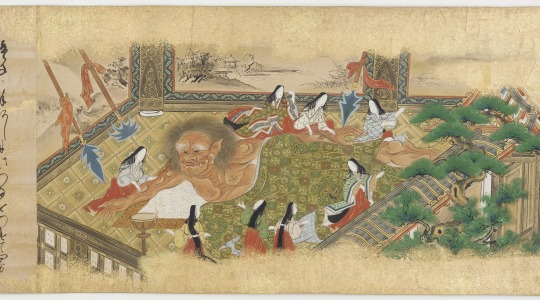
Sleeping Shuten Dōji (National Museum of Asian Art; reproduced here for educational purposes only)
The protagonists finally witness Shuten Dōji's oni form. He is five jō (around fifteen meters) tall, has fifteen eyes and five horns. His head and torso are red, his right arm is yellow, his left arm is blue, his right leg is white and his left leg is black. This might be a reference to the five elements. Alternatively, he could be described as entirely red, which might either be yet another way to reference his love of alcohol, as in the case of the shōjō, or an indication he was comparable to a “plague deity” (疫神, ekijin). The manifestations of the deities from earlier show up again, this time to hold Shuten Dōji in place so that Raikō can strike. He cuts off his head, but to his shock it rises into the air and starts talking.

Confrontation between the heroes and the floating head of , as depicted by Yoshitsuya Utagawa (wikimedia commons)
Shuten Dōji actually mocks the heroes: “How sad, you priests! You said you do not lie. There is nothing false in the words of demons.” Needless to say, his final words are pretty directly referenced in Touhou. Oni, at the very least, claim they do not lie. Mileage of course varies, though. ZUN is not the only author drawn to this element of the legend. It would appear that even the Japan Oni Cultural Museum has advertised itself with the words “there is nothing false in the words of demons” in the past. As noted by Noriko T. Reider, emphasizing this apparent honesty (or naivete) sometimes serves as a way to make oni sympathetic or even relatable for modern audiences. However, it's worth noting that in the noh version, Raikō pushes back against Shuten Dōji’s words, and points out even the claim oni do not lie is a lie. He has a point, considering some versions outright establish oni capture their victims by disguising themselves as people close to them, imitating their voices. It probably also should be pointed out that in Konjaku Monogatari, oni are said to be scary precisely because they can tell apart right and wrong.
Anyway, oni ethics aside, it turns out that to kill Shuten Dōji for good, one has to gouge out his eyes. Once that is accomplished, Raikō's mission is finally complete. After killing the other oni, the protagonists take the head with them to Kyoto. Obviously, they also take the freed captives with them. The young women return to their families, and the Chinese men head for the coast to find a ship which could take them home. They promise to let the emperor (the Chinese one, for clarity; that would be Zhenzong of Song in 995) about Raikō's heroism. In the versions where the woman washing clothes was elderly, rather than simply one of the young captives, on the way back the protagonists learn that she has passed away in the meanwhile, since her lifespan was unnaturally extended by Shuten Dōji. Once he died, so did she.

Transport of Shuten Dōji's head to Kyoto (NYPL Digital Collections)
Before the head can enter the capital, a purification ritual has been performed. Abe no Seimei thankfully knows how to do that. Thanks to him, all the relevant authorities can examine it. The emperor decides it will be best to store it in the treasure house of Uji. This location pops up in multiple legends. The severed heads of the two other equally famous malign entities, Ōtakemaru and Tamamo no Mae, were also stored there according to legends focused on them, in addition to various Buddhist relics and mundane treasures. In an alternate version, the head never reaches the imperial court. Raikō and his retainers encounter the bodhisattva Jizou, who tells them it is too impure to be shown to the emperor, and suggests burying it. The location selected, a hill on the northwestern limits of the city, came to be known as Kubizuka (首塚), literally “head tumulus”. Shuten Dōji actually came to be enshrined there as Kubizuka Daimyōjin (首塚大明神), and in this divine guise developed an association with learning and ailments of the head.
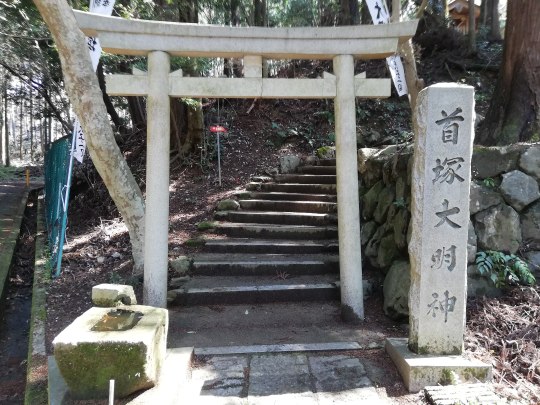
The Kubizuka shrine in 2019 (wikimedia commons)
There is yet another variant tradition about the final fate of Shuten Dōji: after his death he became a vengeful spirit, and then turned into a tsuchigumo, just to be defeated by Raikō and his retainer Tsuna for a second time.
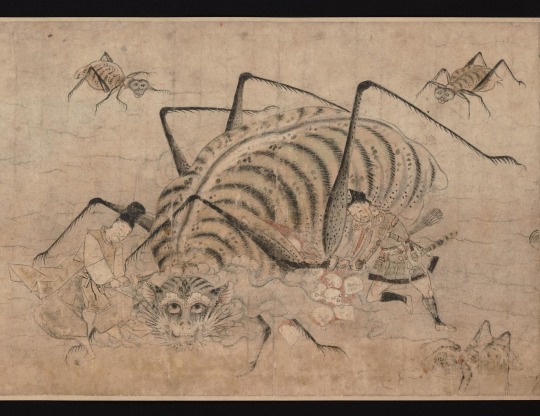
Raikō and Tsuna battling tsuchigumo, as depicted in Tsuchigumo no Sōshi Emaki (wikimedia commons)
Interestingly, it has been argued the tale of Shuten Dōji was at least in part based on that of the tsuchigumo Kugamimi no Mikasa (陸耳御笠), who resided on Mt. Ōe according to Tango Fudoki Zanketsu (丹後風土記残欠). The tale is not preserved fully, though, so all we know for sure other than the location is that the hero opposing him was Hikoimasu no Miko (日子坐王), a stepbrother of emperor Sujin (he is also attested in other sources). A second tsuchigumo, Hikime (匹女) is successfully defeated, but the fate of Mikasa is left unspecified in the surviving sections. This obviously makes further comparisons difficult. The topic of tsuchigumo cannot be dealt with here due to space constraints, but I promise I will return to it in a future article.
The supporting cast of Shuten Dōji
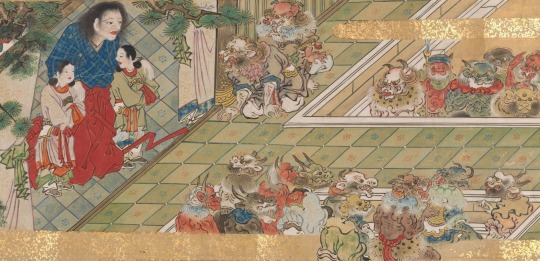
Shuten Dōji in his human form and his oni henchmen (NYPL Digital Collections)
Something that requires further discussion is the matter of the underlings of Shuten Dōji, since it is a topic directly relevant to Touhou. You might have noticed I actually avoided referencing them in any meaningful capacity in the summary of the legend. That’s because they actually do not play a major role. There also wasn’t any consistent view regarding their number or names. However, the version which came to be standard in the Edo period lists four of them - an obvious mirror of Raikō and his entourage. As a matter of fact, both groups even share the same moniker, Four Heavenly Kings.
This idea predates the Edo period, though. An earlier variant based on picture scrolls created by Kanō Motonobu already lists four servants of Shuten Dōji: Gogō, Kiriō, Ahō, and Rasetsu (yes, an oni named Rakshasa). However, two additional oni at his service are also listed, Kanakuma Dōji and Ishikuma Dōji. They are described as his personal guards, and as, well, dōji. It is clear the term is used in a literal sense here - they are said to look like “overgrown adolescents”. Two different subordinates are mentioned in another picture scroll: Kirinmugoku (麒麟無極) and Jakengokudai (邪見極大). However, they do not receive any characterization, or even physically appear in the narrative. Shuten Dōji shouts their names when he is about to die, and the very assumption that he’s referring to his oni subordinates is conjectural. The same version states that there were at least ten oni in the fortress so it’s not like it’s an implausible assumption.
The group of four oni returns in the standard Edo period version, where their names are Hoshikuma (“Star-bear”) Dōji, Kuma (“Bear”) Dōji, Torakuma (“Tiger-bear”) Dōji and Kane (“Iron”) Dōji. There’s also a fifth oni who is not a member of the group of 4, but shares the same naming pattern, Ishikuma Dōji. He actually gets a handful of lines, though they do not really provide him with much of a character beyond establishing he likes sake, that he eats humans, and that he is loyal to Shuten Dōji. Kane Dōji also gets a single line… explicitly alongside Ishikuma and multiple other nameless oni, though, and it boils down to announcing they will go down fighting because without their leader they no longer have a place to go.
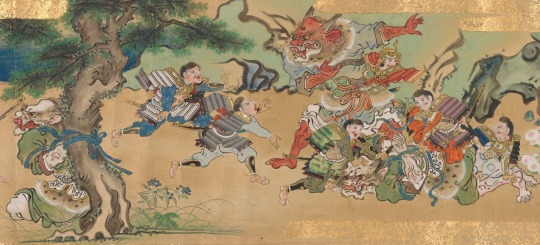
Defeat of the oni (NYPL Digital Collections)
Ibaraki Dōji: Shuten Dōji’s only equal?

Watanabe no Tsuna battling Ibaraki Dōji (wikimedia commons)
A further unique case is that of Ibaraki Dōji, who actually acquired some fame as an individual character, and today is sometimes cited as an example of an oni equally archetypal as Shuten Dōji. Despite being portrayed as a close associate of Shuten Dōji, Ibaraki Dōji to my best knowledge isn’t counted among the Four Heavenly Kings in any version. The character of the connection is evidently more nebulous. I know an assertion that a tradition presenting Ibaraki Dōji as Shuten Dōji’s wife is attested is repeated as fact on wikipedia and various at least semi-credible websites, but there is never a citation provided, and no version of the narrative covered in articles and monographs I have access to includes such an element. I am not claiming it is impossible, though I do feel the fact it doesn’t come up in any paper or monograph discussing either figure I have access to doesn’t mention to might indicate it’s either a recent reinterpretation or a very obscure local variant. Note this is not meant to be an argument against any Touhou ships. What I can say with certainty is that Ibaraki Dōji’s gender is actually a matter of occasional academic dispute. In the versions of the basic Shuten Dōji narrative which mention this oni, he is pretty firmly male. However, he is said to be capable of taking the form of a woman. Noriko T. Reider argues that on this basis it can be effectively assumed that at the very least this specific oni can be considered genderless or capable of freely changing their gender, though she tentatively extrapolates this ability to oni in general. While Ibaraki Dōji’s gender changing adventure is technically its own legend, a reference to it was incorporated into the basic Edo period version of the Shuten Dōji narrative. During the feast, the latter mentions in passing that the former, his trusted ally, lost his arm in a fight with Watanabe no Tsuna during one of their Kyoto raids, after failing to abduct him while disguised as a woman. He clarifies that the arm was later recovered, but not particularly many details are provided. The rivalry between Tsuna and Ibaraki Dōji subsequently comes into play after Shuten Dōji’s death, when the protagonists are about to exterminate the other oni. Ibaraki charges him and they two fight without a clear winner for a while, until Raikō intervenes and kills the oni. I would argue that despite him being responsible for dealing the killing blow, it is Tsuna who should be considered Ibaraki’s nemesis, though. Interestingly, at some point ZUN considered featuring a character based on him in Wild and Horned Hermit (source). That obviously did not come to pass, though. Tsuna already fights an oni in Heike Tsuruginomaki, and many other variants of the story were written subsequently, with the noh play Rashōmon being the most famous. Curiously, the oldest version makes no reference to Shuten Dōji, and the oni actually resides on Mt. Atago, but by the Edo period the two were regarded as allies operating from Mt. Ōe. The details are otherwise generally similar across all of the sources. Raikō sends Tsuna on an errand. He encounters a woman on the Modoribashi Bridge in Kyoto, but as soon as he offers to take her with him she turns into an oni. Thinking quickly, he cuts off the creature’s arm, which is enough to make them flee. He keeps the severed limb as a trophy. Some time later, he is visited by an old woman who he assumes is his aunt... but who turns out to be the same oni, who uses a brief moment of confusion to recover the arm and fly away.
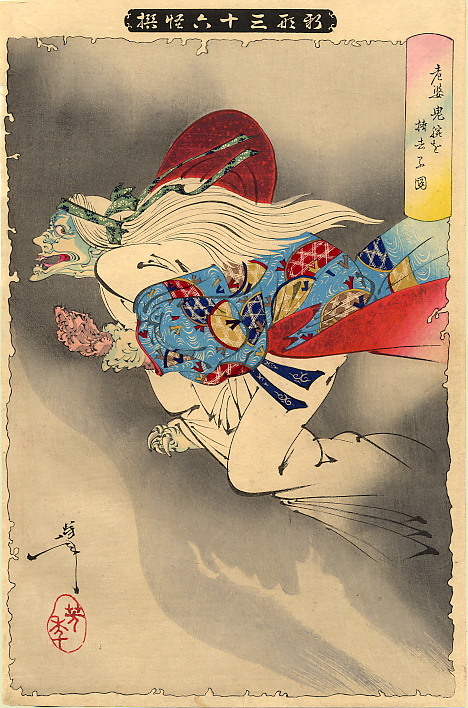
Transformed Ibaraki Dōji, as depicted by Tsukioka Yoshitoshi (wikimedia commons)
The legend of Ibaraki Dōji was evidently reasonably popular in the Edo period, and could even be utilized to comedic ends. One example is an Edo period satirical pamphlet, Thousand Arms of Goddess, Julienned: The Secret Recipe of Our Handmade Soup Stock, written by Shiba Zenkō and illustrated by Kitao Masanobu. Here the one-armed Ibaraki Dōji is one of the figures interested in leasing one of the now detached additional arms of the Thousand-Armed Kannon, who has apparently fallen in dire straits (“business slumps are inevitable, even for a Buddha”, comments the narrator, alluding to the financial conditions of the 1780s). As we learn, after making a purchase Ibaraki is disappointed by the lack of hair, and promptly hires a craftsman to add it:

Original translation by Adam L. Kern; reproduced here for educational purposes only. I am not responsible for the typesetting.
In my recent Ten Desires article I’ve already discussed the oni of Rashomon as a character in legends about Yoshika no Miyako, which I won’t repeat here. It will suffice to say that this conflation effectively made Ibaraki a penchant for poetry and fine arts, and that it indirectly put him in the proximity of the pursuit of immortality. Whether this is why ZUN made Ibaraki’s counterpart a wannabe immortal (“hermit”) is difficult to ascertain, but it does not strike me as impossible. The oni of Rashomon actually appears in at least one more legend which similarly portrays him as an enthusiast of the arts, though to my best knowledge this one never came to be reassigned to Ibaraki Dōji. It is centered on a famous biwa player, Minamoto no Hiromasa, who has to resolve the case of mysterious theft of an instrument from the imperial palace. As you can expect, it is revealed to specifically be an exceptional biwa, which bears the name Genjō. Hiromasa surveys the city in hopes of finding it, and eventually hears its distinct tones while passing near the Rashomon gate. He quickly realizes an oni is playing it. He politely asks if he can have it back, since it’s a treasure of the imperial court… and the oni eagerly obeys, thus bringing the story to a happy end. However, we are told Genjō acquired supernatural qualities in the aftermath of the theft, and only played when it felt like it, as if it was a living being. There is a variant which reveals that the oni of Rashomon was in fact the ghost of Genjō’s original maker, a craftsman from India. In this version, Abe no Seimei has to intervene to recover it, and the oni only agrees to return it after being promised a night with a woman he fell in love with who resembles his deceased wife. There is no happy ending here, though, as the woman’s brother convinces her she needs to kill the oni. She fails, and meets such a fate herself instead. It seems that the reader’s sympathy is actually supposed to be with the oni in this case.
Conclusions, or why you should make your own Deva of the Mountain
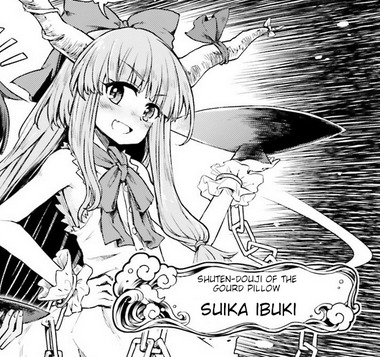
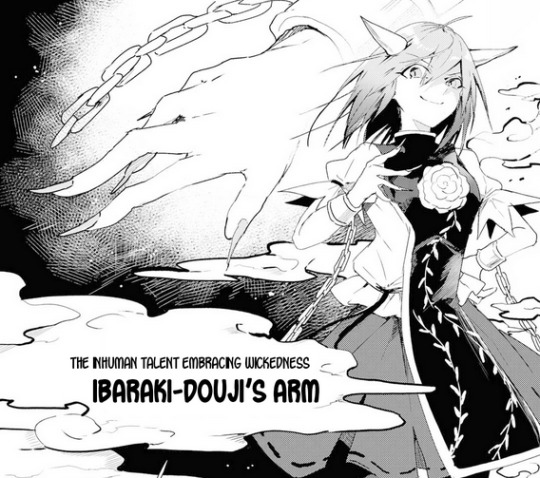
Obviously, there is nothing novel or clever about stating that the two figures this article is focused on, Shuten Dōji and Ibaraki Dōji, correspond to Suika and Kasen respectively. You can learn that from the official media itself, after all. Funnily enough, it seems this might have been even more blunt, judging from unused ideas for referencing the legend to an even greater degree in WaHH, with the defeat at Mt. Ōe as the explanation why oni reside… well, elsewhere (source). Granted, it would also be a disservice to ZUN to say he only created anime girl versions of the classic oni. He effectively created his own versions of both Shuten and Ibaraki - for every similarity between the irl background I’ve described and Touhou, there is also something brand new. That is part of what makes Touhou compelling, I would argue. Naturally, the fact that the group Kasen and Suika belong to is referred to as the Four Devas of the Mountain shows clear inspiration from the Edo period version of the original legends. However, Suika and Kasen are counted among the four, which is obviously an innovation. Additionally, while Yuugi is naturally named after Hoshikuma Dōji, who you were able to meet earlier, save for the name she is effectively a fully original character. Her ability references the Analects of Confucius, rather than anything directly tied to Shuten Dōji. And, on top of that in all honesty, she has more character than any of the additional oni appearing in the real legends. ZUN, as far as I am concerned, created a more than worthy addition to the classics. What about the much discussed fourth deva? I think it’s safe to say that in the light of the discussed material there simply isn’t a single most plausible option. As I stressed already, there’s no consistent group of oni appearing alongside Shuten Dōji, and it cannot be said that the Edo period version is clearly what should be treated as true in Touhou. ZUN picked what he liked from many versions. For what it’s worth, so far all of the oni forming the Four Devas are based on those who share the moniker of dōji, so that’s the closest we have to a theme. As I already said earlier, this term can be simply translated as “child” (or “lad”, though I think a gender neutral option is more apt since we are talking about Touhou here, ultimately). However, it has a more specific meaning when applied to supernatural beings. In this context it refers to a category of ambiguous figures characterized by “vitality, (...) hubris, and (...) unpredictability”, as well as fondness of violence, as summarized by Bernard Faure. Shuten Dōji, and by extension his underlings, are obviously the dōji par excellence. However, the term could also be applied to benevolent, or outright divine beings. That, however, goes beyond the scope of this article. I personally think despite the possible dōji theme the fourth slot will never be filled, ultimately. ZUN likes leaving gaps in established groups - there are types of tengu which were a part of the background for well over a decade, for instance. I think these are left as paths to make ocs with an instant excuse to interact with canon characters. Despite ZUN’s generally pro-fanwork stance I do not think I’ve ever seen anyone make this point. As far as I am concerned, the conclusion is clear: it’s entirely fair game to invent characters to fill the empty spot. There’s even a solid case to be made for reinventing oni from other legends as members of the Four Devas - remember that much of Ibaraki Dōji’s character was borrowed from a nameless oni from a legend about the Rashomon gate, as I discussed last month.
Bibliography
Bernard Faure, Rage and Ravage (Gods of Medieval Japan vol. 3)
Michael Daniel Foster, The Book of Yokai. Mysterious Creatures of Japanese Folklore
Adam L. Kern, Thousand Arms of Goddess, Julienned: The Secret Recipe of Our Handmade Soup Stock, written by Shiba Zenkō and illustrated by Kitao Masanobu (translation and commentary), in: An Edo Anthology: Literature from Japan’s Mega-City, 1750–1850
Keller Kimbrough and Haruo Shirane (eds.), Monsters, Animals, and Other Worlds. A Collection of Short Medieval Japanese Tales
Irene H. Lin, The Ideology of Imagination: The Tale of Shuten Dōji as a Kenmon Discourse
Michelle Osterfeld Li, Human of the Heart: Pitiful Oni in Medieval Japan in: The Ashgate Research Companion to Monsters and the Monstrous
Noriko T. Reider, Shuten Dōji: "Drunken Demon"
Idem, Japanese Demon Lore
Idem, Seven Demon Stories from Medieval Japan
also check out the scans of an amazing Shuten Dōji picture scroll from the NYPL collection here!
166 notes
·
View notes
Text
Ato Matsuri at Gion, Kyoto by arisachw
It started in 869 A.D. when Kyoto suffers a an epidemic that Emperor Seiwa commissioned the ceremony to pray to Susanoo-no-Mikoto, the deity of Yasaka Shrine.
Today, the tradition continues as it becomes a UNESCO Intangible Cultural Heritage because of how much it showcases Kyoto’s history, arts and culture.
More info on the event
33 notes
·
View notes
Photo

Ninigi
Ninigi-no-Mikoto, or simply Ninigi, is the grandson of the supreme Shinto deity Amaterasu, the sun goddess. He is the son of Ama-no-Oshiho-mimi and, descending to earth as the first just ruler, he brought with him gifts from Amaterasu as symbols of his authority which remain part of the Japanese imperial regalia today. Ninigi became the great-grandfather of Japan's first emperor, the semi-legendary Emperor Jimmu, and so established a divine link between all subsequent emperors and the gods.
Ninigi Descends from the Heavens
In Japanese mythology, the sun goddess Amaterasu Omikami asked her son Ama-no-Oshiho-mimi to descend from the heavens to rule the world of the mortals. Twice refusing this honour after seeing the general chaos that prevailed in the world, Ama-no-Oshiho-mimi nominated his son Ninigi-no-Mikoto (full name: Ame-Nigishi-Kuninigishi-Amatsu-hiko-no-ninigi-no-mikoto) to go in his place. To this Amaterasu finally agreed, and she gave Ningi three gifts to help him on his way. These were the Yasakani, a fabulous jewel (or pearls or magatama beads), source of the ancient quarrel between Amaterasu and her brother Susanoo, the storm god; the Yata, the mirror which had been made by the gods and successfully used to tempt Amaterasu out of the cave which she hid in following some typical bad behaviour from Susanoo; and Kusanagi, the great sword Susanoo had plucked from a monster's tail. These would become the three emblems of Ninigi's power (sanshu no jingi), and they became the imperial regalia of his descendants, the emperors of Japan, starting with his great-grandson Emperor Jimmu (r. 660-585 BCE). Thus, all subsequent emperors were able to claim a direct descent from the gods and so legitimise their authority to rule Japan.
The celebrated 7th-century CE poet Kakinomoto Hitomaro composed this poem on Ninigi's descent to govern humanity:
At the beginning of heaven and earth
The eight hundred, the thousand myriads of gods
Assembled in high council
On the shining beach of the Heavenly River,
Consigned the Government of the Heavens
Unto the Goddess Hirume , the Heaven-
Illuminating One,
And the government for all time,
As long as heaven and earth endured,
Of the Rice-abounding Land of Reed Plains
Unto her divine offspring,
Who, parting the eightfold clouds of the sky,
Made his godly descent upon the earth.
Manyoshi (Keene, 104-105)
Amaterasu also gave Ninigi some specific instructions regarding the Yata mirror: "Consider this mirror as thou wast wont to consider my soul, and honour it as myself" (Hackin, 395). Eventually, the mirror would indeed become an object of worship or shintai and end up in the Ise Grand Shrine in the Mie Prefecture, dedicated to Amaterasu and still today Japan's most important Shinto shrine.
Ninigi, carrying his three precious goods, and accompanied by three gods (including Ame-no-uzume, the dawn goddess, and Sarutahiko-no-kami, the god of crossroads) and five chiefs, landed on earth at the top of Mt. Takachiho, in the south of Kyushu. From there, after first building himself a palace, he went to the temple of Kasasa in Satsuma province where the five chiefs set about laying down the principles of the Shinto religion, creating a priesthood and organising the building of temples. The chiefs would pacify the land and establish the clans which would dominate Japanese government for centuries to come such as the Fujiwara clan. In this capacity, the five became the ancestral deities of these clans, the ujigami.
Continue reading...
46 notes
·
View notes
Video
20240503 Anjo shrines 9 by Bong Grit Via Flickr: 更に移動して、矢作川沿いの素戔鳴(すさのお)神社。きっと三河地震も耐えてきた鳥居。 @Susanoo shrine, Anjo city, Aichi pref. (愛知県安城市 素戔鳴神社)
#Stone lantern#Lantern#Stone statue#Stone#Statue#Komainu#Guardian dog#Tree#Trees#Torii#Shrine’s gate#Rope#Shimenawa#Paper#Shide#Nature#Plant#Susanoo shrine#Shinto shrine#Shinto#Shrine#Ogawa town#Anjo#Aichi#Japan#RICOH#RICOH GR3#flickr
6 notes
·
View notes
Text
(Final speculation before 163 comes up) Could the story really wrap up within 4 episodes if Kamiki isn’t a god?
I don’t think so;; There are too many things that can be explained with this way but make no sense if it's not. I'm serious. This must be it. This CAN explain EVERYTHING about that particular character quite smoothly!! To the extent it almost can't be otherwise!
Ahh I jotted this down on the spot (used machine translate.. Sorry if the phrasings are a bit off because if it) please, take this into consideration yeah I can be SO off, already proven off but?? This though just keeps coming to me.
I’ve made a lot of guesses about gods, haven’t I? But no one really seems to take it so seriously.
But didn’t they mention there are “gods” who don’t know they’re gods in the piece itself? Why bring that up? They’re going to use it, right? After hearing the lyrics of *Fatal*, I started to seriously think that Ruby and Kamiki actually have some kind of divine power.
For Kamiki… everything he’s done makes way more sense if we consider him to be the earthly god Sarutahiko Okami. It's just impossible for him to just be a regular person with this little time left in the story but if you take him as a reincarnation of that particular god that's started to reawaken his divinity, everything starts to click!!!
Sarutahiko is considered a "noble" god,
And the way he met Ai is really similar to how he met his wife, Ame-no-Uzume, leading to their marriage (his wife came to his domain as part of a mission, and he led the way, they developed feelings and connected—this parallels how Ai came to meet Kamiki while pursuing acting, with him having guided her. The descendants of the god Sarutahiko bear the name that means "woman who dances well" That's like Ruby). They fell in love immediately, just like Ai seems to have taken a liking to him from the moment she saw him. Ame-no-Uzume approached him first and the relationship blossomed from there.
Sarutahiko is also a god of light (Hikaru has “light” in his name, and “Kamiki” relates to gods).
He governs land (isn’t it strange how people keep dying in the mountains?).
That shrine in Miyazaki where the main cast went to, Aratate Shrine, is dedicated to Sarutahiko and his wife, but they didn’t mention Sarutahiko explicitly. Together, these gods bless the entertainment world and grant people’s wishes. Remember when Ruby and Kamiki met and that whole talk about gods and wishes? He listened to what she really wished for, and Kamiki also congratulated Aqua, saying his wish was fulfilled. All the wishes that were mentioned there, indeed, did come true. In *Mephisto*, the line “I forgot who I lived as” refers to Kamiki, I'm sure of it. He’s a god who didn’t realize it but is now somewhat aware and using his power.
Aqua tried to drown him. Sarutahiko governs the earth, so it makes sense that Aqua, who’s aligned with Susanoo (the sea god), would have an advantage over him in water. That’s why he could kill him that way.
Sarutahiko is also the “guiding god.” He leads people toward good futures, that's what he is supposed to do. So, if Aqua says, “I have to stop you from ruining Ruby’s future,” it makes sense that Kamiki, as Sarutahiko’s reincarnation, might actually have the power to affect her future.
In *Mephisto* and *Fatal*, there’s a narrator desperately longing for a “star,” with Ai being compared to a star and Kamiki to a gem. Gems are from the earth, and Sarutahiko is an earth god (Kunitsukami), while his wife Ame-no-Uzume belongs to the celestial gods (Amatsukami). This all fits perfectly, doesn’t it? Kamiki wanted to reach Ai, and as the songs imply, he tried to gather "light" (the star eyes) as a means to do so. He couldn't get to her by his own powers because he doesn't originate from the skies the way she does, perhaps that could be why he needed the "stars" in order to "fill in what's missing" as mentioned in Fatal! As he originally blessed the entertainment world. Maybe he’s been going around finding people with star eyes to reclaim his blessings.
Actually, if we follow the mythology, Ruby is the one connected to Kamiki out of the twins. Sarutahiko’s essence is solar, and Amaterasu, who corresponds to Ruby, took over his place in the native religion. But even though Sarutahiko gave up his place, (getting married with Ame-no-Uzume in the process.. He did get a beautiful wife out of it all), he’s still honored as a powerful god with the title Okami. His story is more closely tied to Amaterasu and Ame-no-Uzume than to Susanoo. The three of them weren’t on bad terms either. Sarutahiko ended up working with his wife for Amaterasu. So when Kamiki treated Ruby with kindness, maybe it was because they share a deep connection. To add, since they overlap in their domains, so perhaps Kamiki posed a threat to her because of that.
Sarutahiko was said to have a strong, loving relationship with his wife. When they blessed people, they did it together, even offering marriage blessings. The song Mephisto and Fatal just scream that the speaker cannot bear to go on without their loved one and they'd give their life away if only they could be back. I feel that's how Sarutahiko would feel if he lost Ame-no-Uzume, they seemed so loving towards each other to me.
Kamiki’s character really seems to make sense if you consider him a god. There are so many things that would instantly click into place. But if he’s not a god, I honestly have no idea who he is. Everything about him points to that conclusion. Both he and Ai were gods. It makes sense then, that it's Ruby and Kamiki who could say that Ai was just a regular person. Because they think they really are just normal people and wish to be taken that way the way Ai is. They're the ones who can talk from those same shoes.
In reality, they were gods who wanted to live as humans and chose to live as such. Kamiki constantly says that he and Ai were the same, and that they could have overcome anything together. That’s probably because, as gods, they were each other’s counterparts, worshiped together at shrines. That's not just him being clingy, it REALLY was how things were. They were drawn to each other, unconsciously recognizing their similarities, and reunited as humans.
But after Ai’s death, Kamiki was fully corrupted, leading to his downfall.
Honestly, I can’t interpret it any other way anymore. If not this, then I really don’t know who Kamiki is. Too many unnatural things have happened surrounding him, and when you piece together the songs, it becomes clear: he’s a fallen god who lost someone precious and was consumed by darkness. This darkness probably didn’t originate from him; something external caused his fall. Even the scene where his eyes change—like paint dripping from outside—suggests that something seeped in from the outside.
In the anime, Kamiki’s eye color is lighter and more washed-out compared to Ai’s vibrant purple. It really seems like his original eye color was different and was later tainted. He might have been a god of light with orange or yellow eyes. His children’s eye colors might have split because of his original bright color.
Ai, as Ame-no-Uzume, is a goddess of entertainment and the dawn. Her colors align with this. Even if her personality was a façade, she shares a lot of traits with Ame-no-Uzume. If she had grown up without trauma, she might have truly been like her. The “morning/first star(in IDOL's lyric)” refers to the brightest star at dawn. If Ai is Ame-no-Uzume, and Kamiki is her husband, then their relationship with Ruby fits perfectly too. Even in the novel, Ai said she might become a god with her own religion.
I think this should be it. If not, nothing else would make sense. With only 4 episodes left, they’ll likely use this storyline to tie everything up. Otherwise, they’d need a lot more episodes. But since there’s an overarching mythology at play, I think they’ll be able to compress the narrative. No one could deny that these gods loved each other, and because Kamiki is falling into corruption, it'd make sense for there to be divine intervention- the resurrection of the twins. Ai wanted to experience true love, and she did find her match as Kamiki. She wouldn’t have found anyone better because they are meant to be. She wanted to save him from the depravity of the entertainment world.
I wanted to write this down since there won’t be many more chances to talk about these theories.
I’ve been thinking this since *Fatal* came out in July. The more I watch, the more these ideas seem to fit perfectly. The thought only strengthened;; Kamiki and Ai are probably incarnations of gods. The entire Hoshino family is likely divine.
#oshi no ko#oshi no theories#hikaai#hikaru kamiki#ai hoshino#ruby hoshino#aqua hoshino#oshi no ko spoilers#spoilers#long post#this...just works REALLY WELL;;#and I have no idea what this'd be if it isn't at this point
16 notes
·
View notes
Text
Allen x Deuce — AU #2: Japanese folklore


AU by @althea-and-alcestris // designs by me
More about the AU under the cut!
AU summary
I'll make a proper explanation post for this AU once I finish the ship illust... but the gist is that it evolves around Japanese folklore! Characters are humans, mythical beings, or Japanese deities, and their outfits are inspired by both traditional Japanese wear as well as traits of the original characters themselves.
The original AU was made by @althea-and-alcestris and is inspired by Inuyasha.
Ship lore (short summary)
Susanoo is the deity of both storms and the ocean, and the possible natural disasters he could cause terrify him. In order to prevent them, he walks the land in a human vessel named "Allen", which greatly restricts his powers.
Susanoo maintains "Allen" through an artifact. Originally given to and protected by a shrine maiden named Lady Alcestris, the jewel was burned alongside her body and eventually reborn into a human named Deuce.
Deuce is currently an archer-in-training whose goal is it to protect Susanoo's shrine from evil. However, he is still fairly weak and incapable of protecting the shrine on his own. He also isn't aware of the fact that he carries an artifact inside his body until he meets the mysterious Allen for the first time and his entire body starts aching... Why was this? Who was this mysterious man? And... what were these feelings?
Other notes
Deuce in his 20s here, and Allen is physically in his 20s as well.
Allen and Deuce first met when Allen was passing by and Deuce accidentally injured him with an arrow during training. Deuce then nursed him back to health while struggling with the effects of the artifact going haywire himself.
Deuce isn't aware that the beautiful young man is Susanoo, the deity he worships and whose shrine he protects, for quite some time.
#spade of storms#twst#disney twisted wonderland#twisted wonderland#deuce spade#deuce x oc#deuce x yuu#twst au#deuce x allen#twst oc#twisted wonderland oc#yuu twisted wonderland#twst yuu#twisted wonderland yuu#twst deuce#twisted wonderland deuce#twst fanart#twisted wonderland fanart#twst art#twst mc#twst prefect#twst x oc#oc x canon#twst yume#yumeship#allen alagona
42 notes
·
View notes
Text
From the exhibition:
When creating certain aspects of Malevolent Shrine's design, Akutami Gege apparently referenced Daiitoku-myōō (大威徳明王) - a deity of Vajrayana Buddhism, known as the 'destroyer of death' and sometimes conceptualised as 'conqueror of the lord of death', and Gozu Tennō (牛頭天王) - a Japanese deity of disease and healing, who was regarded since the Heian period both as a causer of and protector against epidemics and eventually became merged with the native kami Susanoo.
First, let's take a look at Daiitoku-myōō:

He manifests in several different forms, one of which has six legs, six faces and six arms holding various weapons while sitting or standing on a water buffalo (sometimes depicted surrounded by flames). The topmost face is the wrathful aspect of Mañjuśrī (a bodhisattva who represents transcendent wisdom) with a red face below it. The other faces are yellow, dark blue, red, black, white, grey, and brown. Each face has three eyes. In Chinese Esoteric Buddhism and Shingon Buddhism, he is pictured with six faces, legs and arms holding various weapons while sitting on a white ox.
Now, let's look at Gozu Tennō:

Gozu Tennō was usually portrayed as a fierce-looking man with the head of an ox above his head. He is sometimes shown wielding an axe in one hand and a noose or lasso in the other, though other depictions may instead show him brandishing a sword or a halberd. He may be clad either in Indian-style garments, a suit of armor, or in Japanese Heian period clothing. Some artworks might depict the deity with multiple arms and heads: a late Heian period statue in Sakai, Osaka Prefecture for instance shows him with three faces and four arms. Another statue in Tsushima, Aichi Prefecture depicts him with twelve arms, four heads (two fierce human heads each with a single horn, a horse's head, and an ox's head), and bird talons for feet.
I think the aspects Akutami Gege took from these two figures when depicting Sukuna inside his innate domain and creating Malevolent Shrine are quite clear and this new information from the exhibition does give us a better insight behind the creation of his character.
#akutami gege~~~ well done once again when it comes to sukuna.#there is so much more i want to say on the connection between these two figures and sukuna but...#for now this will do...#sukuna#jjk sukuna#sukuna ryomen#ryomen sukuna#ryoumen sukuna#jjk#jujutsu kaisen
30 notes
·
View notes
Text
Very Light JJK Spoilers
I’ve seen a lot of criticism about Sukuna as a villain. But I don’t think many people have taken the time to enjoy the time of big brain he is. We see this intelligence of his on full display during the Big Raga Incident.



- here upon ariving on the scene, Sukuna was able to deduce very quickly that:
1: Mahoraga is a Shikigami summoned by Megumi, despite never knowing about Mahoraga. Or the 10 shadows technique outside of what he’s learned from past battles during the Heian era and or his time in Yuji’s prison
2: Megumi’s subjugation ritual keeping him in a suspended state, and thus, he can’t die until Big Raga is dealt with.
3: Haruta staying alive being crucial to keeping Megumi alive throughout the ritual.
Sukuna is so familiar with Shikigami users and rituals associated to them, he’s able to figure in a few seconds everything that’s going on and what he probably needs to do. No other character in the series has demonstrated this level of analytical accuracy, this quickly.



- Here, Sukuna is able to identify what Mahoraga’s sword can do from their first exchange. It’s clear he’s seen or read about it before in the past. We don’t know all the battles he’s been a part of but he is clearly well versed in some ancient weapons as seen as during his battle with Kashimo.
Sukuna may be an avid enjoyer of his curse technique, Shrine, but he’s a fan of weapons, mainly in a lot of his Heian era artwork. Mainly a staff like weapon and then that lightning weapon he used against Kashimo. Let’s not forget to mention all of his past Heian era battles gave him a lot of experience. Who’s to say none of those sorcerers carried a cursed weapon. Based off of his current battle with our cast, he seems pretty used to sword users.
In short, Sukuna knows his way around cursed weapons, and is able identify what they’re capable of. He is also very capable of dealing with a weapon user, barehanded.




- lastly, we see Sukuna compare Big Raga to a something named Yamata no Orochi. Now Yamata no Orochi the Legendary 8 Headed/Tailed Dragon, in real life is a mythical creature first written about around the early 700s in Japan, “filled with malice” and eating young girl sacrifices every seven years. Later, Susanoo, the god of Storms, kills it. It’s known for having a few amazing powers but the main one is regeneration from damage, even death.
Now Sukuna may be referencing the actual mythology, since it was around during the Heian Era, which started at 794 AD and ended in 1185 AD. It’s plausible to assume Sukuna grew up well aware of the mythology. Or perhaps in the JJK universe, there was a Shikigami that may have created the legend we know today. Regardless, upon identifying how Big Raga preferred to stop his ops, via, adaptation, he activated Malevolent Shrine, to create the right conditions for him to use Fire Arrow.
(A quick aside for context, recently it’s been confirmed by Gege that Sukuna’s activation of Fire Arrow is simplified and buffed by the storm of cleave and dismantle turning everything into a fine powder in an air tight enviorment/ie his domain, so when the Fire Arrow activates, it causes an instantaneous explosion, disintegrating any and everything within the domain.)
I’m not saying the manga or anime implies Sukuna fought Yamata no Orochi, but it seems clear Sukuna knows how to deal with an adapting enemy: Obliderate it with an attack it can’t heal from, adapt to, or come back from.
I really enjoy how Gege writes action in JJK. In many cases, it tells you a lot about the characters involved and I believe the Mahoraga fight is one of the best, because it fully demonstrates how well experienced Sukuna is.
#Gege writes manga like it’s a novel#idk how to explain it#but I love it#fight analysis#character analysis#jujutus kaisen#jjk season 2#ryomen sukuna#mahoraga#megumi fushiguro#haruta shigemo#lol#good anime#wtf#funny as hell#good manga#dank#anime memes#funny
30 notes
·
View notes
Text
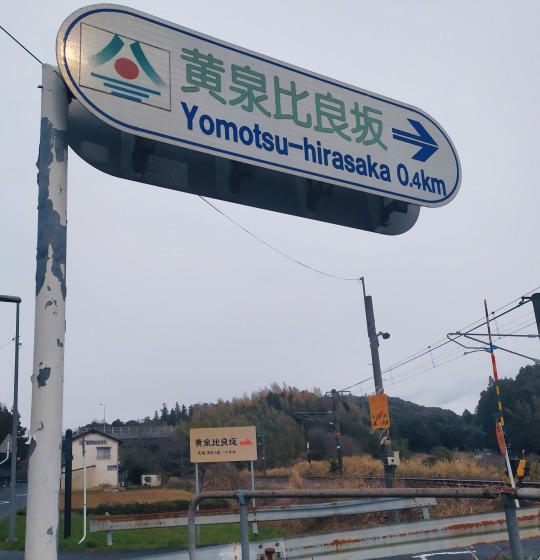
due to a change of plans I went to Yomotsu Hirasaka today instead of a few days ago! I got older places to post about in my backlog but I figured something like this would be more interesting to my touhou followers rn
before that though, I did a quick detour at Iya shrine as suggested by the person running the little tourism office/souvenir shop/town association (very nice place btw)


it enshrines Izanami mainly, but also Ookuninushi/Oonamuchi, Sukunabikona (!), Kotoshironushi, and I spotted a few smaller shrines for Susanoo etc. plus the usual Inari of course. the shrine office was exceptionally closed when I got there but they'd left goshuin outside for visitors, so I paid mine and got on my way to the main place I'd come here for
Yomotsu Hirasaka is on a little hill (obviously) almost completely cut from the rest of town, which made for a relaxing walk. I saw a bunch of abandoned barns and gardening sheds in the fields on the way there, and there's a pretty big pond right next to it with huge carps in it. anyway

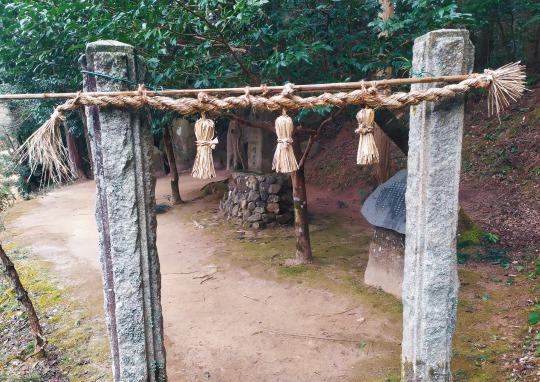
that's where Izanagi supposedly sealed the path to Yomi to prevent Izanami and her girls from catching him. funnily enough, most of the informational material there and the leaflets I got at the tourism office call the pursuers some variant of "oni" or "evil spirit". for example:
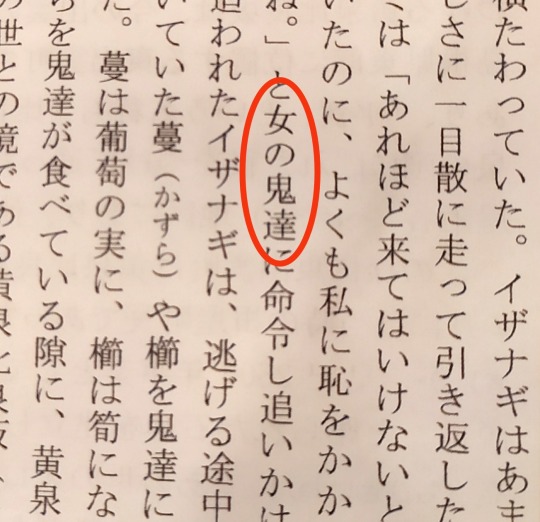
but on a stone monument right next to the rocks themselves, the word "shikome" is what's used:

food for thought... 😏 there was also a board with some more local information and a QR code to a narrated video of this episode of the Kojiki and I thought it was honestly pretty well done so here it is: link (the sound can get a bit loud at times so beware). the shikome look hilarious in it tbh I'd suggest watching it at least for them
on the way back I used a shortcut through the forest and found a little place dedicated to Sai no kami/Dousojin. in retrospect I should've seen it coming, but it was still a surprise to find something that can be kinda linked to a certain other character right there in the middle of the woods

37 notes
·
View notes
Text
I've only touched on this briefly, but the reason Tsukuyomi is Susanoo's shadow and their similar appearances is due to the theory that they're actually the same person.
-Tsukuyomi has a suspicious lack of appearances despite being such an important deity. This is actually one of the greatest mysteries in Japanese Mythology. Nobody knows what happened here.
-Tsukuyomi has way less shrines compared to Susanoo and Amaterasu, which gives the impression that he was actually introduced later than his siblings or was hidden for some reason.
-It's been pointed out that Susanoo doesn't follow the same naming convention as Amaterasu and Tsukuyomi, so this has led some to believe that Susanoo might've been a nickname for someone else. Amaterasu's name relates to the sun and can be translated as "Great Divinity Illuminating Heaven”. Tsukuyomi's name relates to the moon and means "moon-reading". Susanoo's name does not relate to storms nor the sea and instead means "wild or impetuous male".
-Tsukuyomi and Susanoo are both blamed for the death of the food goddess, Ukemochi. In the Nihongi, Amaterasu sends Tsukuyomi to a feast on her behalf and there he discovers that the goddess Ukemochi actually made all of the food there by spitting it up. Tsukuyomi becomes so disgusted and enraged that he hacked Ukemochi to pieces. This upsets Amaterasu and leads to their divorce, explaining the existence of night and day. It's also believed that Amaterasu actually sends Susanoo to the feast on her behalf. There is also a story from the Kojiki where, after Susanoo was banished from Takamagahara, he asks Ōgetsu-hime aka Ukemochi for some food. She complies and does so by creating food by spitting it up and defecating. Susanoo gets grossed out and believes she's trying to poison him, so he hacks her to pieces, similar to Tsukuyomi.
-Tsukuyomi's and Susanoo's realms also connect due to the gravity of the moon effecting the sea.
-Tsukuyomi and Susanoo both rule over the underworld in different interpretations.
The fact that Tsukuyomi is still treated as one of the Big 3 with Susanoo and Amaterasu, despite having so little going on compared to his siblings and just from the connection alone, is so interesting. He really is the middle sibling 🌞🌙⛈️.
28 notes
·
View notes
Text
ㅤ𐑙 ࣪ ۫ ୧ ࣫ ִ 𝕬stra 𝓥enus 🪐𑁯 💫 ୨୨



I am Venus, or Astra whatever you decide to call me, at the moment I am 18 years old, my zodiac is cancer on sun, and my MTBI is INTP. I am Mexican but speak English and I am learning Dutch/German and French. I am a pagan baby witch, and love mythology specially Greek and Egyptian. I am here to reblog, post and this is going to be a digital grimoire of my practice.

MY PAGANISM PATH
I have always been attracted to mythology, especially Greek and Egyptian, and I can say I feel some connection to the gods, especially Anubis, Aphrodite, Hermes and Morpheus. I started worshipping Aphrodite in the past but didn’t put that much effort like right now, but it was two years ago, so my official date of initiation in paganism as a regular practice I will say it’s in November 2024.
Worshipping: Artemis, Apollo, Zeus, Aphrodite, Hermes
Honoring: Hera, Ares, Athena
Investigating till I feel ready: Hestia, Anubis, Ra, Isis, Bastet, Loki, Freyja, Hel, Hecate, Hades, Persephone, Morpheus, Nyx
Other deities that I feel a connection with : Amaterasu, Susanoo, Tsukuyomi, Shiva, Lucifer, Lilith, Beelzebub
My tumblr shrines:
Apollo and Artemis🌙☀️
Zeus and Hera⚡️🦚
Aphrodite and Ares⚔️🐬
Hermes and Dionysus🍇💸
Athena🗡️
Hades and Persephone💀🥀
Morpheus and Hypnos🌌🪶
Nyx and Hekate✨🌑
Hestia🔥
Eros💌
Selene and Helios🌞🌝
Poseidon and Amphitrite🔱🧜♀️
My notion shrines:
(Working on it)

MY SPIRITUAL PRACTICE
I have been around the spiritual/witchy world around 6 years, but never been consistent and never investigated and knew enough to stop being a baby witch, but paganism and witchcraft are like a home for me, it is my safe place, it is there when I need it and this time I want to make this a dedicated practice.
Interests/Practices
Lucid Dreaming
Astral Projection
Dream Work
Divination (Mainly Tarot and Oracle)
Crystals
The moon <3
Astrology
Glamour Magick
Pink Magick
Deity Work
Channeling
Other Interests/Practices
Reality Shifting
Manifestation
Chakra Healing
My Digital Book of Shadows

And that’s it, if you have similar interest, or just want mutual feel free to dm through here or discord. Also please note that in my post (if I ever post something of info) please take it with a grain of salt, it is more the way I feel and perceive things; kinda UPG.
9 notes
·
View notes